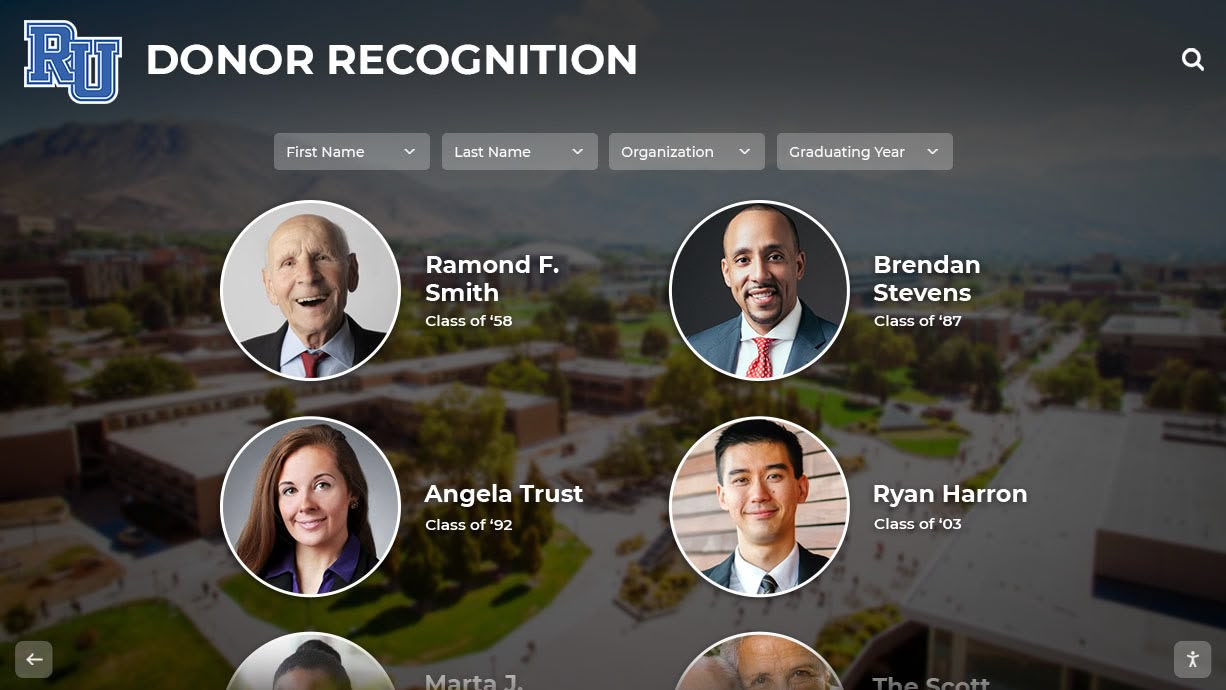Alumni giving rates have reached historic lows across American higher education. According to industry research, average alumni participation rates declined to 7.8% in 2023—down from roughly 20% in the 1980s. More concerning, 72% of alumni report experiencing “solicitation fatigue,” where constant asks for donations without engagement have reduced their willingness to participate or donate. Yet some institutions buck these trends, achieving significantly higher participation rates and stronger donor retention through innovative recognition strategies that transform how graduates connect with their alma maters.
The difference isn’t luck or exceptionally wealthy alumni populations—it’s strategic deployment of digital displays that honor contributions, tell compelling impact stories, and create emotional connections that inspire continued giving. Interactive recognition technology transforms passive donor acknowledgment into active engagement tools that demonstrate genuine appreciation while showing exactly how philanthropy creates meaningful change. This comprehensive guide explores how digital displays inspire alumni to give back through proven psychological principles, practical implementation strategies, and measurable outcomes that justify investment.
Why Digital Recognition Drives Alumni Giving
Traditional brass plaques and static donor walls acknowledge giving but rarely inspire it. Digital displays create dynamic experiences that connect donors emotionally to mission impact while providing the transparency and authentic appreciation that today's alumni expect. Solutions like Rocket Alumni Solutions provide purpose-built platforms specifically designed to honor donors in ways that strengthen relationships and encourage continued philanthropic support.
The Psychology Behind Recognition-Driven Giving
Understanding why recognition influences giving behavior provides essential foundation for creating displays that actually move donors to action rather than simply acknowledging past contributions.
Social Proof and Peer Influence
Humans are fundamentally social creatures who look to others when making decisions—especially about behaviors like charitable giving where social norms significantly influence participation. When alumni see respected community members recognized for their contributions, giving transforms from exceptional generosity to expected community participation.
Establishing Giving Norms: Digital displays showcasing diverse donors at various giving levels create powerful social proof that philanthropy represents normal alumni behavior rather than rarified activity limited to wealthy graduates. When prospective donors see hundreds of classmates, teammates, and professional peers recognized for their support, the question shifts from “Should I give?” to “At what level should I participate?”
Research from behavioral economics consistently demonstrates that individuals are significantly more likely to donate when they observe others in their reference group making similar contributions. Digital recognition displays make this social proof continuously visible—unlike traditional acknowledgment methods where recognition might appear once in a printed honor roll then disappear.
Gift Level Anchoring: Recognition displays create reference points for giving decisions by showing the distribution of donor participation across various giving levels. When prospects see that many alumni contribute at $500, $1,000, or $5,000 levels, these amounts become mental benchmarks rather than arbitrary thresholds. Digital systems that organize recognition by giving societies and clearly defined tiers provide especially effective anchoring because they make progression pathways transparent.
Studies on donor behavior indicate that when recognized meaningfully, donors show demonstrable increases in giving patterns: 43% higher retention rates compared to unrecognized peers, 23% larger subsequent gifts following initial recognition, and accelerated giving timelines with shortened periods between consecutive contributions.
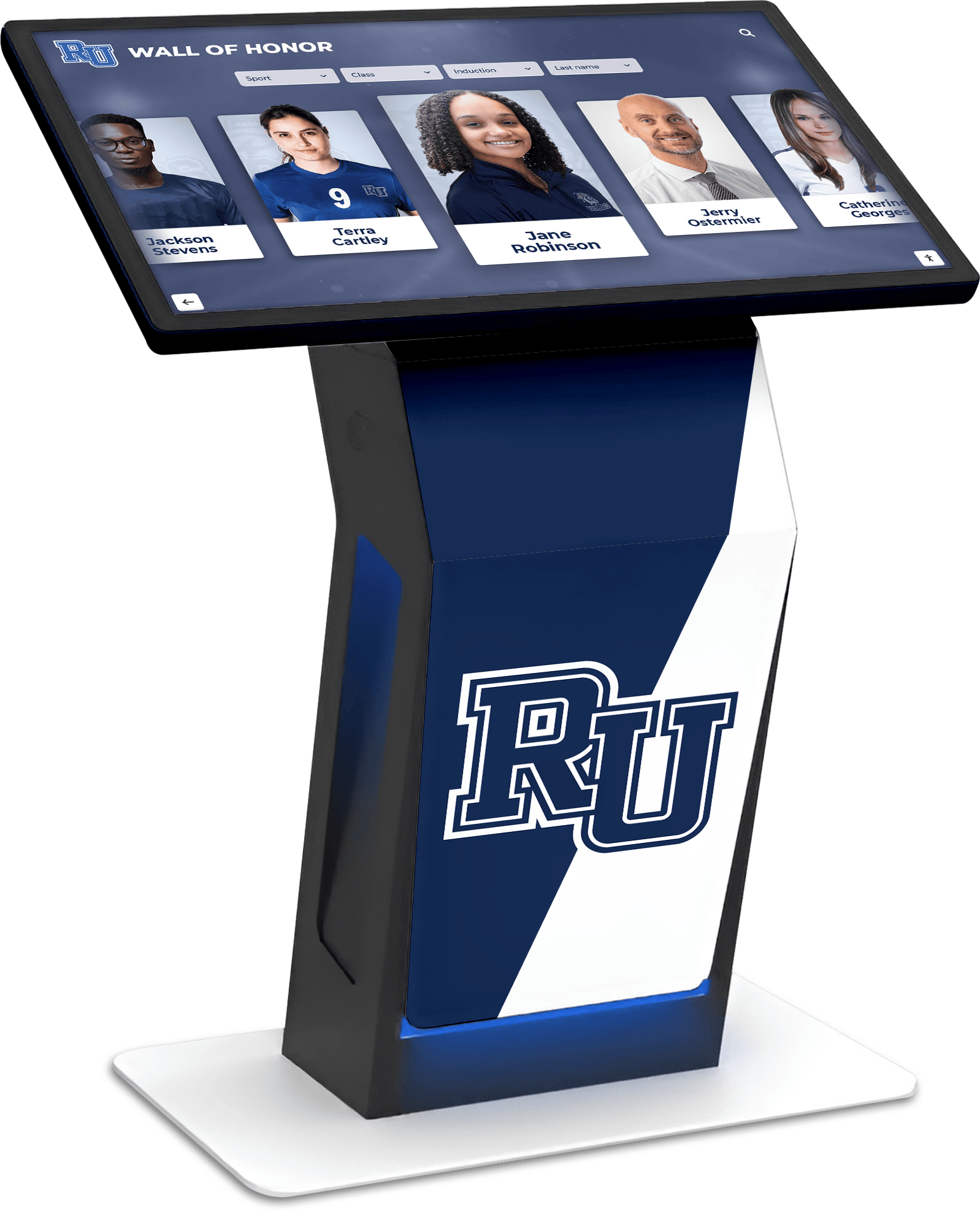
Emotional Connection Through Storytelling
Factual acknowledgment—names and dollar amounts—provides information but rarely creates the emotional resonance that inspires continued giving. Digital displays enable rich multimedia storytelling that brings donor impact to life in ways traditional recognition cannot match.
Impact Visualization: The most compelling recognition doesn’t just acknowledge what donors gave—it demonstrates what their gifts accomplished. Digital displays can feature:
- Video testimonials from scholarship recipients describing how donor support changed their educational trajectories
- Photo galleries showing facilities that philanthropic gifts built or renovated
- Infographics illustrating aggregate campaign impact across multiple program areas
- Before-and-after comparisons demonstrating tangible improvements donor support created
- Student success stories directly connecting financial aid to graduation outcomes
When donors see the faces of students their scholarships supported or tour facilities their gifts created, abstract philanthropy becomes tangibly real. According to fundraising research, 75% of alumni want more transparency on how their donations are used, with 48% saying they would increase their giving if they had clearer insights into the impact of their contributions.
Personal Narratives: Digital recognition allows donors to tell their own stories—explaining why they give, what their alma mater meant to them, and what they hope their contributions will accomplish. These first-person narratives create authentic connections far more powerful than institutional descriptions. When prospective donors read or watch peers explaining their giving motivations, they’re exposed to genuine testimonials that resonate more effectively than any marketing message could.
Recognition as Stewardship That Retains Donors
Donor retention represents fundraising’s most critical metric because acquiring new donors costs significantly more than retaining existing supporters. Proper recognition serves as continuous stewardship that maintains engagement between solicitation cycles.
Timely Acknowledgment: Digital systems enable immediate recognition updates—donors can see their contributions acknowledged within days of making gifts rather than waiting months for physical plaques. This immediacy satisfies the fundamental human need for acknowledgment when motivation peaks, reinforcing giving decisions through instant validation.
Ongoing Visibility: Unlike thank-you letters that donors read once then discard, digital displays provide persistent recognition visible during every campus visit or web portal access. This ongoing acknowledgment maintains relationship warmth and keeps institutional connections top-of-mind, creating sustained engagement that traditional stewardship methods struggle to match.
Research from advancement professionals indicates that institutions implementing comprehensive recognition programs experience 20-35% improvements in donor retention rates. More significantly, 60-80% of major donors make additional significant gifts within five years when they experience meaningful stewardship and recognition—demonstrating that initial giving represents testing behavior where donors assess institutional trustworthiness before considering larger commitments.
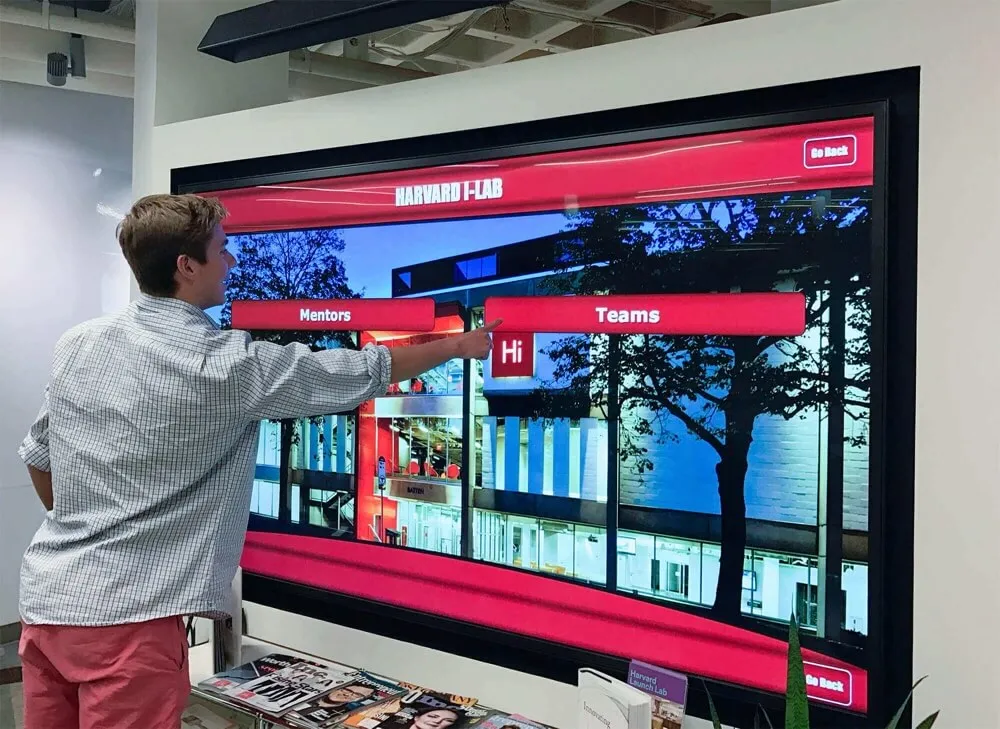
Strategic Implementation: Creating Displays That Inspire Giving
Technology enables compelling recognition experiences, but strategic design and content determine whether displays actually influence giving behavior. Several key implementation principles separate recognition that drives philanthropy from displays that merely acknowledge past contributions.
Comprehensive Inclusion That Honors All Donors
One of the most powerful aspects of digital recognition compared to traditional approaches: unlimited capacity that enables truly comprehensive acknowledgment across all giving levels.
Eliminating Threshold Anxiety: Traditional physical displays with limited space force difficult decisions about which donors to recognize, often establishing minimum gift thresholds that exclude modest but meaningful contributors. This creates the unfortunate impression that smaller gifts don’t matter—precisely the wrong message for institutions trying to build broad participation.
Digital displays eliminate these constraints, allowing schools to recognize every donor regardless of gift size while maintaining appropriate distinctions for leadership giving. When annual fund contributors see their $100 donations acknowledged alongside $100,000 major gifts—appropriately categorized and scaled—it validates their participation and encourages renewal.
Tiered Recognition Architecture: While honoring all donors, effective digital systems maintain clear hierarchies that acknowledge contribution magnitude:
- Leadership Circle ($100,000+): Transformational gifts with enhanced profile prominence, detailed impact documentation, and special designation badges
- Principal Donors ($25,000-$99,999): Major commitments featuring comprehensive biographical profiles and donor testimonials
- Benefactor Society ($10,000-$24,999): Significant support with standard recognition profiles and appreciation
- Sustaining Supporters ($1,000-$9,999): Consistent contributors acknowledged with essential recognition
- Annual Fund Friends (under $1,000): All participants honored, validating every contribution to institutional mission
This tiered approach creates aspirational progression pathways—donors at lower levels see recognition that leadership donors receive and can envision their own future participation at higher tiers as circumstances allow. Solutions like interactive digital donor walls enable this sophisticated segmentation while maintaining inclusive recognition that traditional plaques cannot provide.
Real-Time Campaign Progress Visualization
Capital campaigns and major initiatives require sustained visibility and momentum-building throughout multi-year timelines. Digital displays serve as dynamic campaign headquarters that keep goals visible, progress transparent, and accomplishment celebrated.
Progress Thermometers and Milestones: Real-time tracking showing current fundraising totals compared to campaign goals creates urgency and demonstrates momentum. As gifts are processed and totals climb toward targets, displays automatically update to reflect current status—providing visible evidence of community support that encourages additional participation.
This transparency builds donor confidence that campaigns will succeed while creating healthy competition among graduating classes, departments, or donor societies. When prospects see their cohort falling behind peer groups in participation rates, it creates motivation for catching up that can be surprisingly powerful.
Leadership Gift Recognition: Prominently featuring pace-setting gifts creates powerful social proof. When prospects see peers making major commitments, it normalizes leadership giving and demonstrates that transformational philanthropy represents attainable behavior within institutional communities.
Digital platforms enable sophisticated leadership recognition that highlights both gift amounts and donor motivations through video messages explaining why donors gave, impact statements describing what gifts enable, and appreciation from institutional leadership. This rich acknowledgment provides aspirational models while honoring pace-setters appropriately.
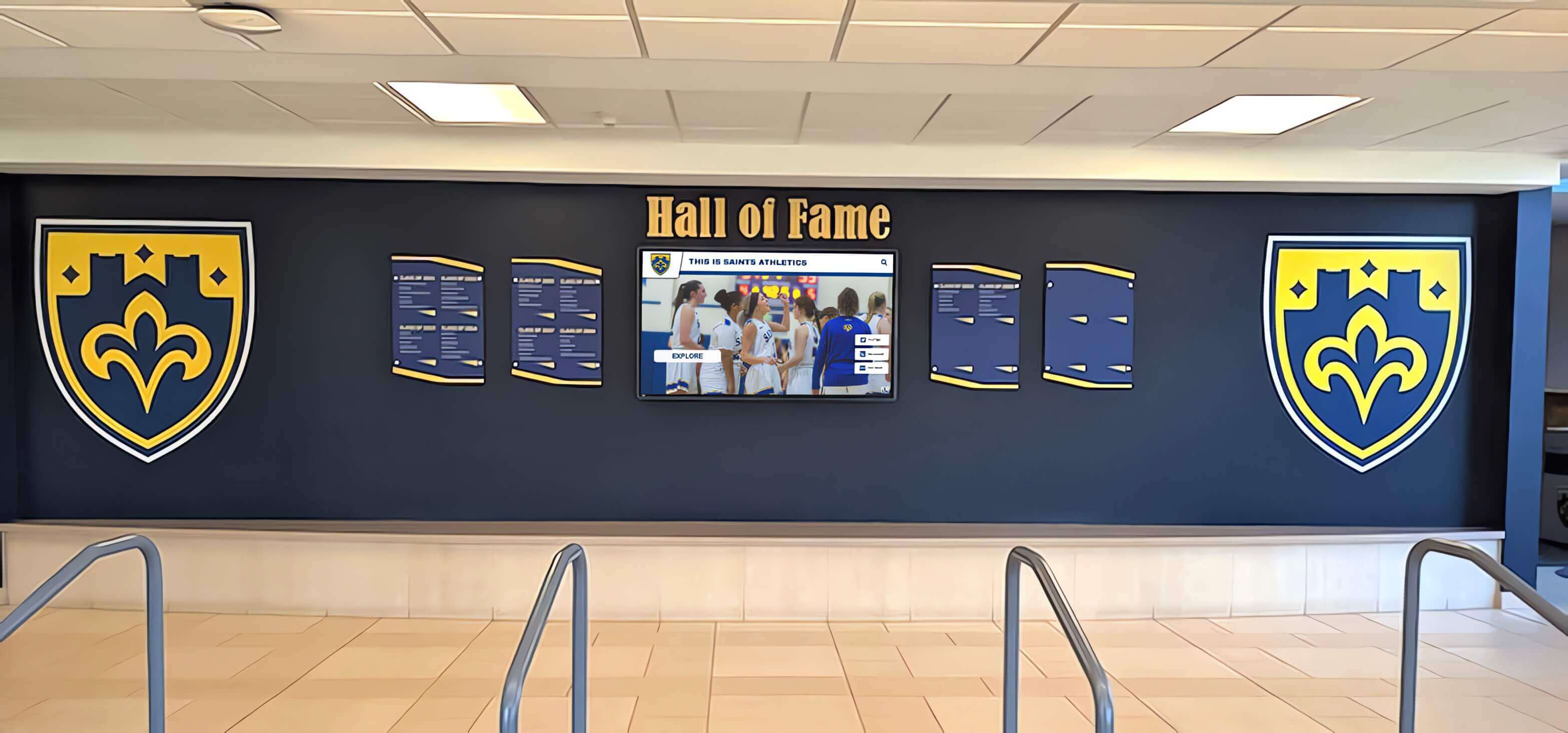
Compelling Impact Storytelling That Connects Giving to Outcomes
The most effective recognition explicitly demonstrates how donor contributions created meaningful change. Rather than stopping at gift acknowledgment, strategic displays show exactly what philanthropy accomplished.
Student Success Stories: Feature profiles of scholarship recipients discussing how financial aid enabled their education, complete with updates on their subsequent career success and community contributions. When donors see that their $10,000 endowment gift continues supporting students annually in perpetuity, the long-term impact becomes tangibly real.
Facility Transformations: Before-and-after photography showing facilities that donor support built, renovated, or equipped creates visual evidence of philanthropic impact. Virtual tours or 360-degree experiences allow remote donors to “visit” spaces their gifts created, even when they cannot physically return to campus.
Program Outcomes: Data visualizations illustrating how donor support enabled measurable improvements—increased graduation rates among scholarship recipients, expanded research output from endowed faculty positions, enhanced athletic performance from improved training facilities, or broadened community service reach through program funding. These outcome metrics transform abstract giving into concrete results that validate donor decisions.
Institutions implementing comprehensive impact storytelling within recognition displays consistently report that donors engage more deeply with these narratives than with any other content—spending multiple minutes exploring impact documentation compared to seconds scanning name lists. This engagement creates the emotional connections that inspire continued and increased support.
Technological Features That Maximize Engagement and Giving
Beyond strategic content, specific technological capabilities separate recognition displays that inspire giving from those that simply acknowledge past contributions.
Interactive Search and Discovery
Digital displays should invite exploration through intuitive search functionality that enables personalized discovery experiences.
Personal Connection Discovery: Alumni visiting recognition displays often search first for themselves, then for classmates, teammates, and acquaintances they haven’t thought about in years. When they discover familiar names and can easily explore those profiles, it creates reconnection moments that strengthen institutional bonds while demonstrating the breadth of community support.
Giving Level Exploration: Prospects considering contributions at specific levels can filter displays to see all donors at those thresholds—understanding exactly who gives at various amounts and what recognition they receive. This transparency helps prospects calibrate their own giving decisions based on observed community norms.
Geographic and Professional Filters: Enable searching by location or career field, allowing alumni to discover fellow graduates in their regions or industries. These discovery pathways create networking value beyond recognition alone—and research shows that engaged alumni give at significantly higher rates than disconnected alumni.
Advanced platforms from providers like Rocket Alumni Solutions provide sophisticated filtering that accommodates diverse discovery preferences while maintaining intuitive usability requiring no instructions.
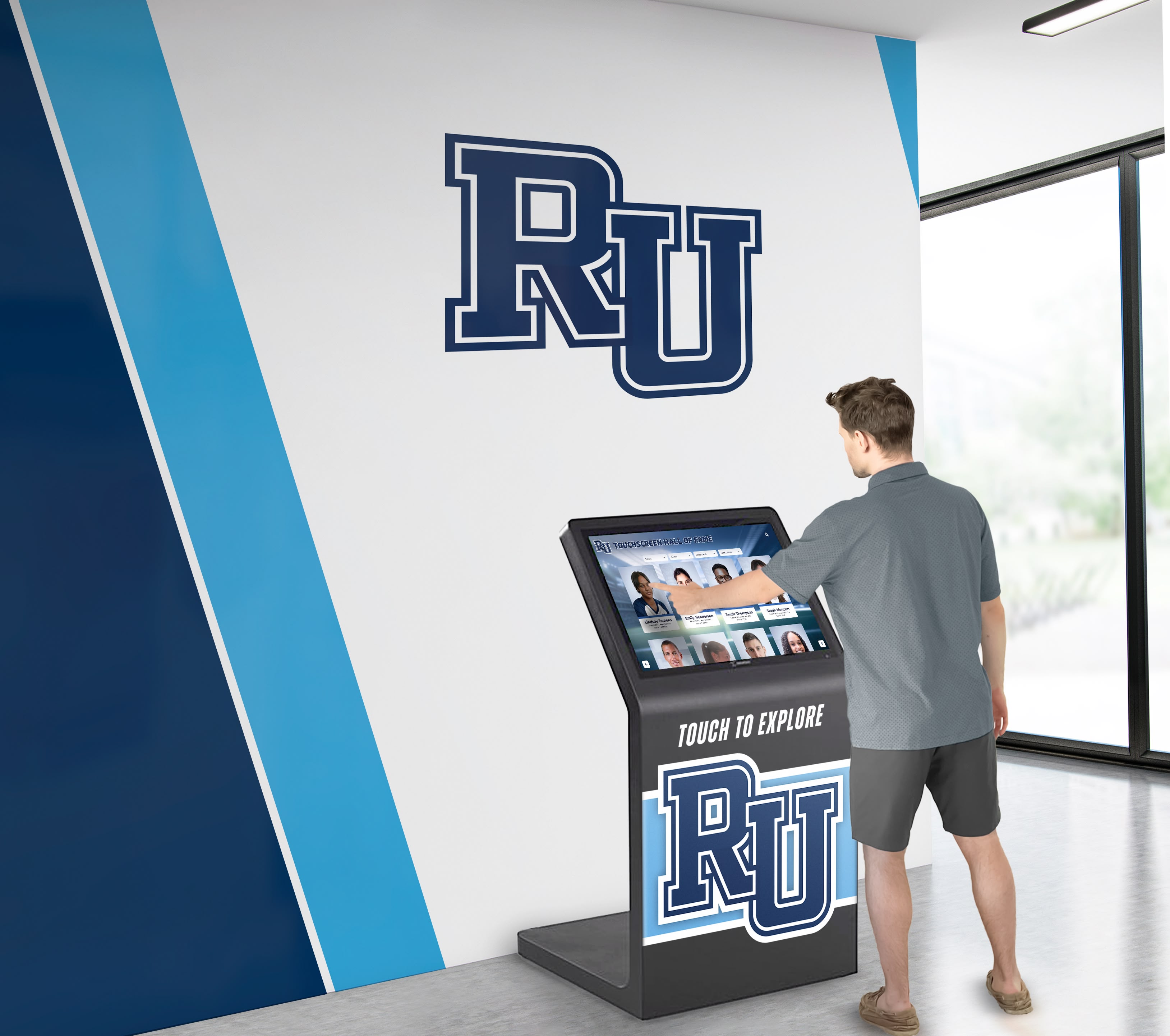
Social Sharing Capabilities
Donors derive satisfaction not just from institutional recognition but from being able to share their philanthropic commitments with personal and professional networks. Digital recognition should facilitate this organic promotion.
One-Touch Social Media Integration: Allow donors to share their recognition profiles directly to LinkedIn, Facebook, Twitter, or Instagram with single-tap functionality. This social amplification extends recognition reach far beyond campus visitors to potentially millions of impressions across donor networks.
QR Code Profile Access: Generate unique QR codes for each donor profile, enabling smartphone-based exploration and sharing. Alumni can scan codes from physical displays to access comprehensive web-based profiles on their personal devices, then easily share via their preferred platforms.
Photo Opportunities: Design displays to create visually appealing backdrops where donors naturally want to photograph themselves with their recognition—encouraging organic social media sharing that introduces institutional missions to new prospect audiences who trust peer recommendations more than traditional marketing.
When donors photograph and share their recognition, they implicitly endorse institutions while demonstrating social proof that encourages peer giving. Research from institutions with social-enabled recognition shows that approximately 40-50% of interactive display visitors share content socially when features make doing so effortless.
Remote Accessibility for Global Alumni
Most alumni live far from campus and may never physically return after graduation. Digital recognition delivered through web portals extends acknowledgment globally, dramatically expanding engagement opportunities.
24/7 Web Access: The same content powering physical campus displays should be accessible online from anywhere in the world. Remote alumni can explore recognition, search for classmates, and view their own acknowledgment without visiting campus physically—maintaining connection regardless of geographic distance.
Mobile Optimization: With most web browsing occurring on smartphones and tablets, recognition platforms must deliver excellent mobile experiences. Responsive design ensures displays work perfectly on any screen size, while touch-optimized navigation provides intuitive interaction on mobile devices.
Email Integration: When institutions add new donors to recognition displays, automated notifications can alert them that their acknowledgment is now live and viewable. These communications provide reasons for alumni to visit recognition platforms, creating engagement touchpoints that maintain ongoing institutional presence.
Organizations implementing both physical and web-based recognition typically observe that 60-75% of total engagement occurs through digital channels, with geographically distant alumni particularly active users. This extended reach transforms recognition from campus-only experiences into global engagement tools that serve all constituencies effectively. Understanding how advancement teams leverage digital recognition provides additional context for maximizing these platforms’ fundraising value.
Measuring Recognition Impact on Giving Outcomes
Investment in recognition technology requires justification through measurable impact on fundraising results. Several key performance indicators reveal whether displays actually influence giving behavior beyond simply acknowledging past contributions.
Direct Giving Metric Improvements
Track changes in core fundraising metrics following recognition display implementation:
Donor Retention Rates: Compare year-over-year retention among recognized donors versus unrecognized peers. Institutions consistently report 15-25 percentage point improvements in retention among donors receiving prominent digital recognition compared to those acknowledged only through thank-you letters.
Average Gift Size Growth: Monitor whether average contributions increase following recognition. Advancement teams report 10-15% growth in average gift sizes within 2-3 years of implementing comprehensive recognition, as donors who feel genuinely appreciated demonstrate increased commitment through larger gifts.
Upgrade Conversion Rates: Track how many donors increase giving levels annually. Recognition displays featuring clearly defined societies and giving tiers create upgrade motivations—donors aspiring to higher recognition levels naturally consider increased contributions. Institutions implementing tiered recognition report upgrade rates improving 8-12% annually.
Major Gift Pipeline Expansion: Monitor whether prospects mention recognition during cultivation conversations or cite displays as factors in giving decisions. Development officers report 20-35% more major gift conversations initiated through recognition display engagement, as prospects use displays to understand how their potential contributions would be acknowledged.
Planned Giving Inquiries: Legacy giving represents transformational philanthropy that provides long-term institutional sustainability. Institutions prominently recognizing planned gift commitments typically observe doubled inquiries from alumni considering estate planning that includes their alma maters.
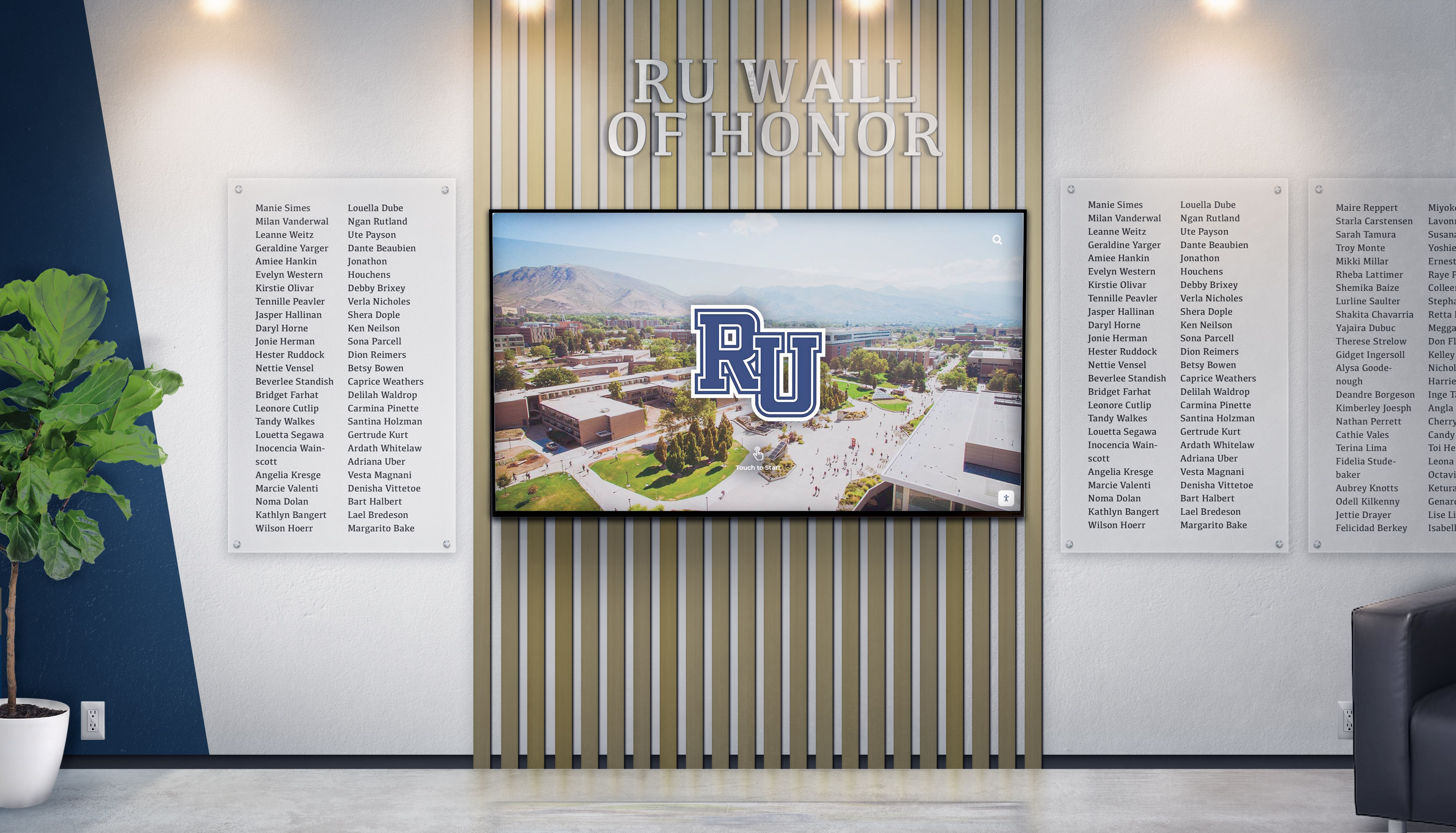
Engagement Analytics That Predict Giving
Digital platforms provide detailed engagement metrics revealing donor interest patterns that inform cultivation strategies:
Display Interaction Frequency: Alumni who repeatedly view recognition displays demonstrate higher engagement levels that correlate with giving likelihood. Advancement teams can identify prospects showing sustained recognition interest, suggesting readiness for solicitation conversations.
Content Engagement Depth: Tracking which profiles, impact stories, and categories receive most attention reveals what resonates with audiences. When certain giving level content generates disproportionate interest, it suggests prospects evaluating potential contributions at those thresholds.
Search Pattern Analysis: Understanding what visitors search for—specific names, giving levels, program areas—reveals information needs and interests. If many searches focus on scholarship donors, it indicates strong interest in educational access that solicitation conversations can emphasize.
These behavioral signals help advancement teams prioritize outreach and tailor conversations to expressed interests—making cultivation more efficient and effective while respecting donor preferences.
ROI Calculation and Cost Justification
Demonstrate recognition technology value through return on investment analysis comparing costs against measurable benefits:
Hard Cost Savings: Digital systems eliminate recurring expenses for plaque production (typically $2,000-5,000 annually), installation labor (typically $1,500-3,000 annually), and physical display maintenance. Over 10-15 year planning horizons, these avoided costs often exceed initial platform investments.
Soft Cost Recovery: Advancement teams typically recover 60-80% of time previously spent managing traditional recognition—equivalent to adding 0.1-0.15 FTE capacity without hiring additional staff. This recovered time redeployed to donor cultivation directly drives revenue growth.
Incremental Giving Gains: Calculate additional funds raised through improved retention, increased average gifts, and enhanced major gift cultivation. Most institutions implementing comprehensive recognition systems document positive financial ROI within 2-4 years when accounting for both cost savings and giving improvements.
For comprehensive frameworks on evaluating recognition program value, explore resources on measuring digital hall of fame ROI that provide detailed assessment methodologies.
Best Practices for Maximum Philanthropic Impact
Institutions achieving exceptional results with recognition-driven giving follow proven practices that maximize donor response:
Launch with Genuine Gratitude, Not Just Obligation
The most effective recognition reflects authentic institutional appreciation rather than perfunctory obligation fulfillment. Displays should feel like genuine celebrations of generosity that changed institutional trajectories—not administrative checkbox exercises.
Personalized Acknowledgment: Generic thank-you templates feel hollow. Effective recognition includes specific details about donor motivations, connections to institutions, and what their particular gifts enabled. When donors see that institutions truly understand why they gave and what it accomplished, recognition resonates emotionally in ways generic acknowledgment cannot match.
Leadership Visibility: Presidential messages, dean videos, or trustee testimonials thanking specific donors demonstrate that gratitude extends beyond development offices to organizational leadership. This high-level appreciation signals that contributions genuinely matter to institutional missions.
Maintain Fresh, Current Content
Static recognition grows invisible over time as visitors memorize displays and stop engaging. Maintaining freshness requires systematic content updates:
Quarterly Donor Additions: Establish predictable cycles for adding newly recognized donors—perhaps coinciding with quarterly giving tallies or annual fund drives. Regular additions provide reasons for repeat visits while demonstrating that recognition remains living, evolving programs.
Annual Profile Updates: Contact living donors annually requesting career updates, new achievements, or changed information. These refresh cycles maintain accuracy while creating engagement touchpoints that strengthen relationships.
Rotating Featured Content: Digital platforms enable scheduled content rotation highlighting different donors, giving societies, or program areas on recurring bases. Homepage features that change weekly or monthly create varied first impressions ensuring displays feel dynamic rather than static.
Integrate Recognition Throughout Advancement Ecosystem
Recognition platforms deliver maximum value when tightly integrated with comprehensive advancement strategies rather than operating as isolated initiatives:
Event Coordination: Feature relevant recognition content during alumni gatherings—reunion year cohorts during reunion weekends, athletic donors during sports events, scholarship supporters during recipient celebrations. Event-aligned content creates conversation starters and photo opportunities that extend recognition impact.
Campaign Integration: Use recognition displays as campaign headquarters showing progress, celebrating leadership gifts, and demonstrating community-wide support. Campaign-focused content maintains initiative visibility throughout multi-year timelines.
Communications Alignment: Monthly featured donors in newsletters, social media spotlights highlighting recently added recognition, and website homepage prominence all extend recognition beyond physical displays—multiplying effective audience reach.
This integrated approach ensures recognition supports rather than exists separately from broader advancement goals. Resources on how digital recognition helps advancement teams provide additional integration strategies.
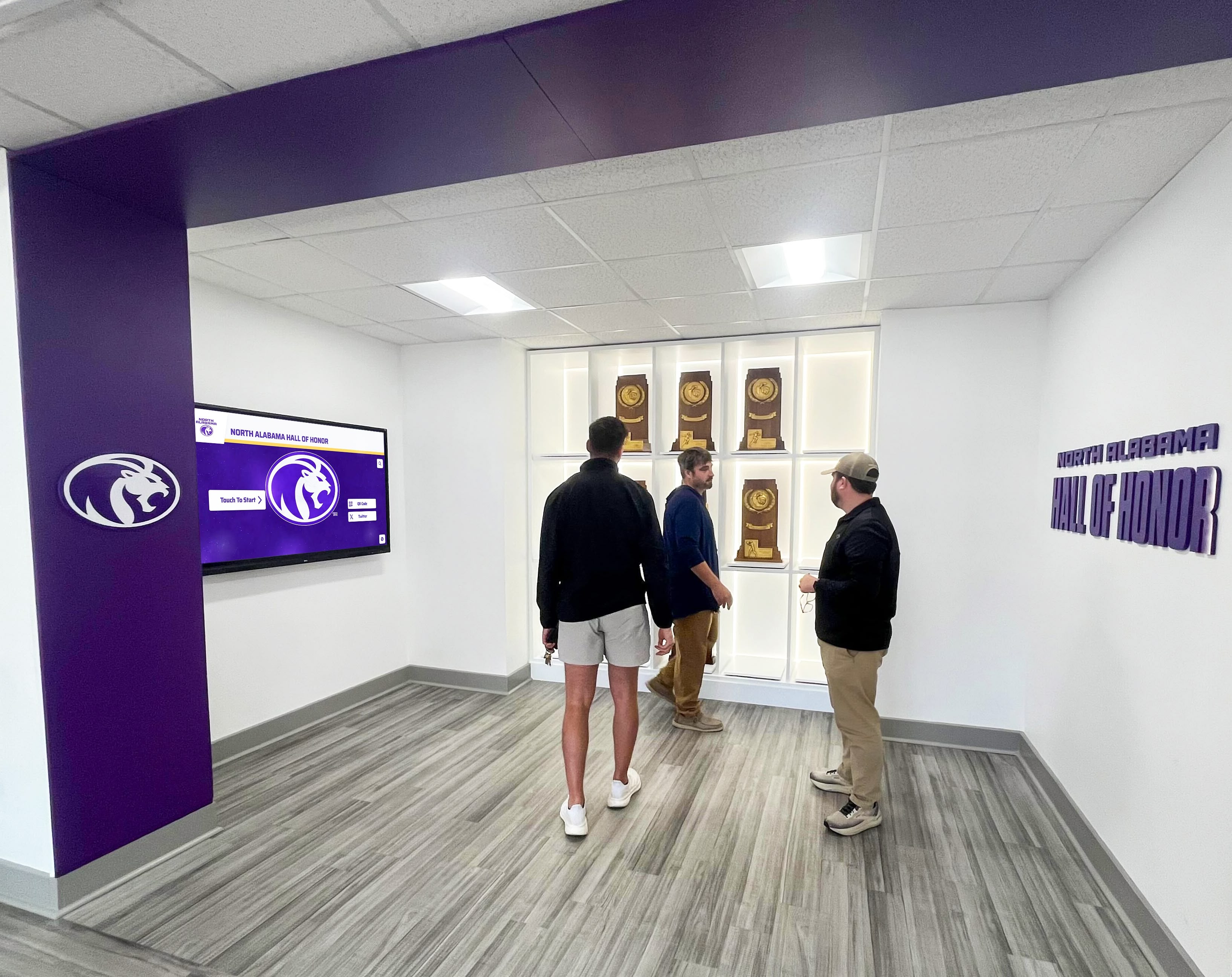
Addressing Common Implementation Concerns
Institutions considering recognition technology often raise predictable questions about investment, maintenance, and effectiveness:
“How do we justify the investment to leadership?”
Present digital recognition as strategic advancement infrastructure rather than discretionary expense. Document total cost of ownership comparing digital systems against ongoing traditional recognition expenses over 10-year periods—traditional approaches typically cost 50-70% more over extended timelines while providing inferior engagement and no analytics.
Demonstrate measurable returns through improved donor retention (15-25% improvements), reduced recognition administration time (60-80% reductions), expanded recognition capacity (unlimited versus 150-300 donors physically), and enhanced cultivation effectiveness (2-4 month cycle reductions). Most institutions discover positive financial ROI within 3-5 years while gaining strategic capabilities traditional recognition never provides regardless of investment level.
“Will donors prefer traditional plaques?”
Research indicates donor preferences focus on meaningful recognition quality rather than specific formats. Donors value timely acknowledgment, prominent visibility, genuine gratitude, and demonstrated impact—dimensions where digital recognition outperforms physical alternatives.
Implement hybrid approaches honoring tradition while embracing innovation. Maintain selective physical recognition for naming opportunities or highest giving societies while providing comprehensive digital recognition for all supporters. This combination respects preferences while solving capacity limitations traditional-only approaches cannot overcome.
“Do we have resources for ongoing content management?”
Digital recognition requires less ongoing maintenance than traditional systems when properly implemented. Recognition that previously required 20 hours monthly for vendor coordination now takes 3-5 hours for routine updates through self-service management.
Establish efficient workflows integrating recognition updates with existing advancement processes. When development officers process gifts in CRM systems, recognition updates occur simultaneously through database integration rather than as separate tasks—preventing recognition from becoming isolated additional burden separate from core advancement functions.
Conclusion: Transforming Alumni Giving Through Strategic Recognition
Alumni giving faces unprecedented challenges across higher education—declining participation rates, donor fatigue, and fierce competition for philanthropic dollars create environments where traditional approaches struggle to maintain support levels. Yet institutions implementing strategic digital recognition that honors contributions meaningfully while demonstrating tangible impact consistently buck these trends, achieving participation rates and donor retention that peer institutions envy.
The evidence is clear: digital displays inspire alumni to give back when implemented thoughtfully with genuine gratitude, compelling impact storytelling, and technological sophistication that creates engaging experiences. Recognition transforms from administrative obligation into powerful stewardship tool that maintains donor engagement, demonstrates institutional appreciation, and provides the transparency about gift impact that contemporary alumni increasingly expect.
Success requires viewing recognition holistically—not isolated acknowledgment but integrated appreciation woven throughout cultivation, stewardship, and engagement activities. By combining strategic content highlighting impact, sophisticated technology enabling personalized discovery, and authentic gratitude reflecting genuine institutional appreciation, schools create recognition experiences that genuinely strengthen relationships while inspiring continued and increased philanthropic support.
For advancement teams ready to transform how recognition drives giving, purpose-built platforms like those from Rocket Alumni Solutions provide comprehensive systems combining proven technology, intuitive management, and strategic features designed specifically to honor donors in ways that strengthen relationships and encourage continued support. Transform recognition from transactional acknowledgment into strategic advancement infrastructure that drives sustained philanthropic success for generations.
Ready to discover how recognition technology can increase your alumni giving? Explore modern digital displays that celebrate generosity while strengthening the donor relationships that sustain institutional missions and advance your most ambitious goals.
